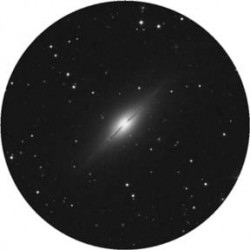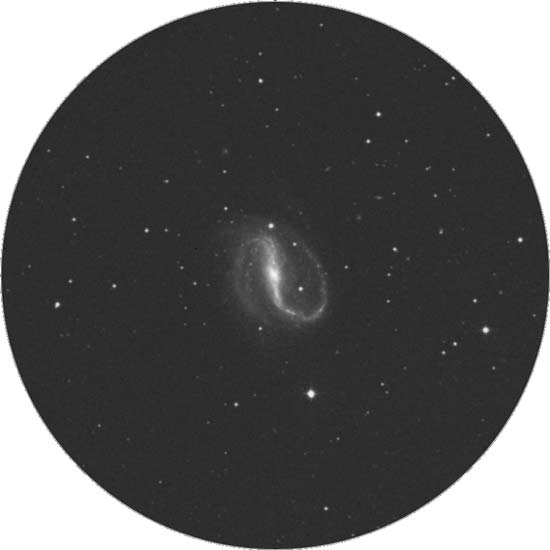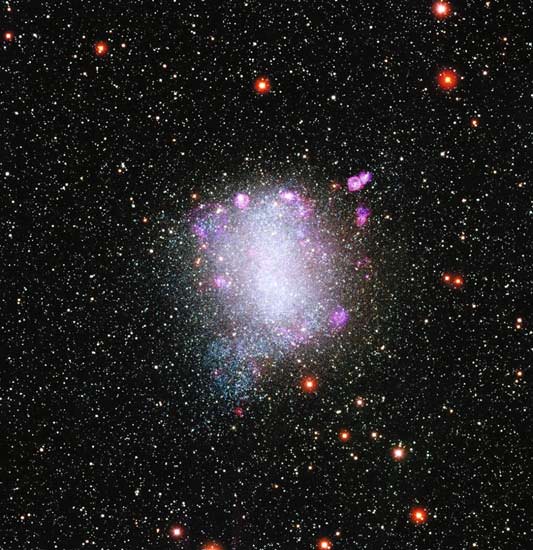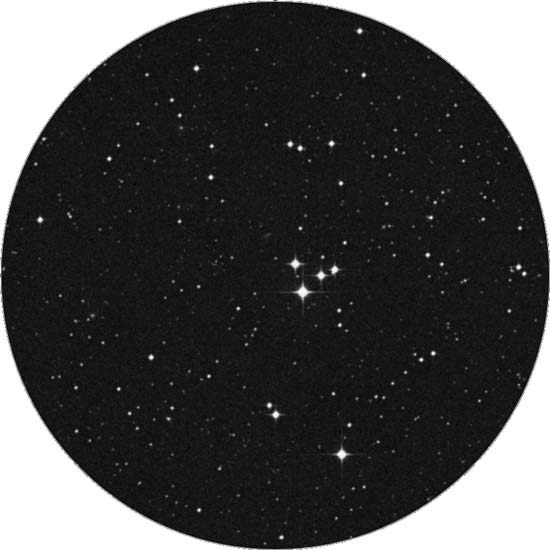Greetings, fellow SkyWatchers! It’s a much darker weekend – and just in time for the Draconid Meteor Shower! If you haven’t been watching the early morning trio of Venus, Mercury and Saturn, there’s still time… Just as there is time to chase a couple of Caldwell Objects and a very challenging galaxy study for more practiced observers. But we’re not forgetting small scopes and binoculars either as we take a look at “What was Charles Messier thinking when he recorded M73?” It’s time to turn your eyes to the skies and I’ll see you in the dark…
Friday, October 9, 2009 – Have you been watching our early morning planetary conjunction? Mercury was nearly touching Saturn 24 hours ago! If you’re up early over the next few days, enjoy celestial mechanics in action as Venus, Mercury and Saturn slowly shift their positions in the sky.
Tonight is the peak of the northern Draconid meteor shower, whose radiant is near the westering constellation of Hercules. This particular shower can be quite impressive when comet Giacobini–Zinner passes near Earth. When this happens, the fall rate jumps to 200 per hour and has even been known to reach 1,000. Comet Giacobini–Zinner reached perihelion on July 2, 2005, passing within 8 million kilometers of Earth but has now greatly distanced itself from our region of the Solar System. Chances are the Draconids will produce only about 3–5 meteors per hour, but this number can vary.
Tonight’s skies remain dark into the early hours, so let’s take this opportunity to have a look at two objects from one of the more obscure catalogs. Set your sights on Alpha Pegasi, and drop due south less than 5 degrees to pick up NGC 7479 (RA 23 04 56 Dec +12 19 23).
Discovered by William Herschel in 1784, this 11-magnitude barred spiral galaxy experienced a supernova as recently as 1990. Although the 16th magnitude event near its nucleus is no longer visible, modest telescopes will easily pick out the bright core and elongation of the central bar. Larger aperture will find this one a real treat, as the spiral arms curl over and under the central structure, resembling a ballet dancer en pointe.
Congratulations! If you’ve found it, you’ve just observed Caldwell 44.
 NGC 7814 is easy enough to find. Start at Gamma Pegasi and use the finderscope to center on a star around 3 degrees northwest (RA 00 03 14 Dec þ16 08 43). In the scope, look southeast to see NGC 7814 as a scratch of light in the low power field. Magnify and enjoy! This galaxy has a deeply concentrated nucleus and a very prominent dissecting dark dust lane. This one is also known by another name, Caldwell 43.
NGC 7814 is easy enough to find. Start at Gamma Pegasi and use the finderscope to center on a star around 3 degrees northwest (RA 00 03 14 Dec þ16 08 43). In the scope, look southeast to see NGC 7814 as a scratch of light in the low power field. Magnify and enjoy! This galaxy has a deeply concentrated nucleus and a very prominent dissecting dark dust lane. This one is also known by another name, Caldwell 43.
Saturday, October 10, 2009 – On this date in 1846, William Lassell was busy at his scope as he made a new discovery, Neptune’s moon Triton. Although our everyday equipment can’t ‘‘see’’ Triton, we can still have a look at Neptune! You’ll find it on the ecliptic around 21:45 in right ascension. On this date 140 years later (1986), a tiny asteroid, Asteroid 3753, was found orbiting Earth. Named Cruithne, the little body will orbit our Earth for at least another 5,000 years from a minimum distance of 15 million kilometers. While time and the stars appear to stand still, and astronomical twilight begins earlier each night, let’s take one last look at the exiting constellation of Sagittarius. Our return study for this evening is a telescopic challenge for skilled observers only. Set your sights about 2 degrees northeast of easy double 54 Sagittarii and around 7 degrees west of Beta Capricorni (RA 19 44 58 Dec –14 48 11), and let’s have a look at NGC 6822.
Often referred to as ‘‘Barnard’s Galaxy’’ for its discoverer (E.E. Barnard, 1884), this unusual customer is actually a member of our local galaxy group. For the 400–600 telescope, this 11th magnitude, 1.7-million-light-year-distant object will not be easy to see, but it can be achieved with good conditions. Lower power is essential in even larger scopes, and those into the 1200–1600mm range will see NGC 6822 burst into stunning resolution. Barnard’s Galaxy almost appears like an open cluster overlaid with nebulosity, but the experienced eye will clearly see that the ‘‘shine’’ behind the stars is galactic in nature. It’s a very clumpy and unusual galaxy, one that you will very much enjoy. Be sure to look for the small, pale blue, 10th magnitude planetary nebula NGC 6818 in the same field to the north-northwest. This pair rocks!
 Sunday, October 11, 2009 – Today we begin with the 1758 birth on this day of Heinrich Olbers, a German astronomer who calculated the orbit of the 1779 comet, discovered the minor planets (asteroids) Pallas (1802) and Vesta (1807), and discovered five comets during his career. Tonight we’ll have a look at a collection of stars as we ponder the age-old mystery of M73. Located about three finger-widths north-northwest of Theta Capricorni (RA 20 59 00 Dec –12 38 00), this 9th magnitude open cluster consisting of four stars was discovered by Charles Messier on October 4, 1780. Messier described it as a ‘‘cluster of three or four small stars, which resembles a nebula at first glance. . ..’’ Hotly debated as to whether or not the grouping is a genuine cluster or simply an asterism, it was also included in J. Herschel’s catalog (GC 4617) and given the NGC 6994 designation by Dreyer. In 1931, Collinder cataloged M73 as Cr 426, with an estimated distance of 12,000 light-years. Still, the debate about its authenticity as a physically related group continues.
Sunday, October 11, 2009 – Today we begin with the 1758 birth on this day of Heinrich Olbers, a German astronomer who calculated the orbit of the 1779 comet, discovered the minor planets (asteroids) Pallas (1802) and Vesta (1807), and discovered five comets during his career. Tonight we’ll have a look at a collection of stars as we ponder the age-old mystery of M73. Located about three finger-widths north-northwest of Theta Capricorni (RA 20 59 00 Dec –12 38 00), this 9th magnitude open cluster consisting of four stars was discovered by Charles Messier on October 4, 1780. Messier described it as a ‘‘cluster of three or four small stars, which resembles a nebula at first glance. . ..’’ Hotly debated as to whether or not the grouping is a genuine cluster or simply an asterism, it was also included in J. Herschel’s catalog (GC 4617) and given the NGC 6994 designation by Dreyer. In 1931, Collinder cataloged M73 as Cr 426, with an estimated distance of 12,000 light-years. Still, the debate about its authenticity as a physically related group continues.
At least two stars show the same proper motion, leading scientists to believe that M73 may be the remnant of a much older and now dispersed cluster—or simply two related stars. Of the 140 stars
investigated in the region, 24 may be real members, including those in Messier’s original observation. Thanks to the work of Hertzsprung and Russell, these candidates fall within the color-magnitude diagram of a 2–3-billion-year-old cluster with Messier’s suspect four being evolved giants. Although more recent data indicate that M73 may simply be an asterism—sharing no common proper motion— you can still enjoy this unusual Messier in even a small telescope!
Until next week? Dreams really do come true when you keep on reaching for the stars!
This week’s awesome images are (in order of appearance): NGC 7479 and NGC 7814 (credit—Palomar Observatory, courtesy of Caltech), NGC 6822 (credit—Local Group Galaxies Survey Team/NOAO/AURA/NSF), Heinrich Olbers (historical image) and M73 (credit—Palomar Observatory, courtesy of Caltech). We thank you so much!




